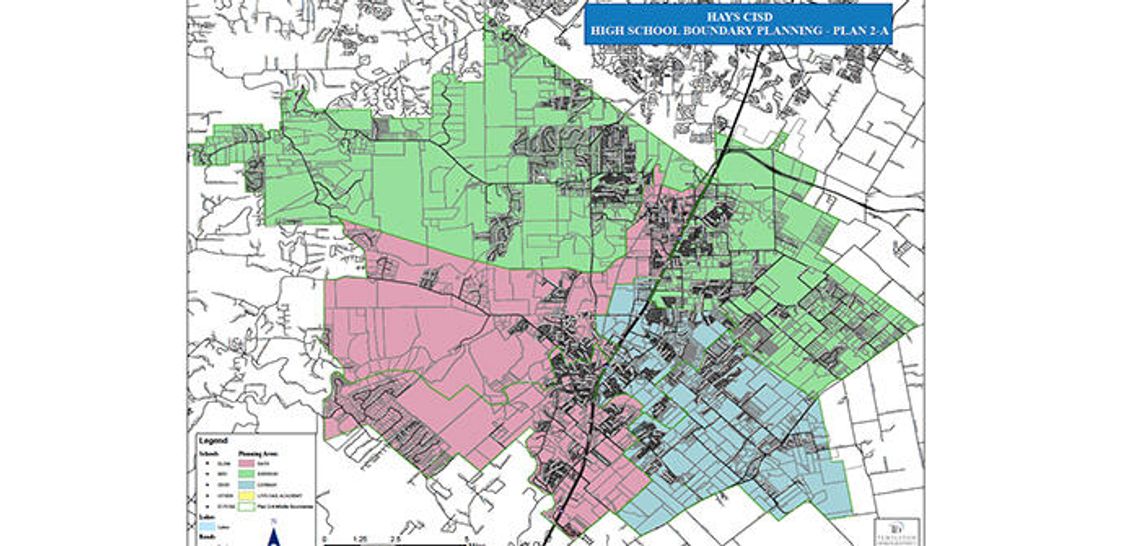After months of community input and debate, the Hays CISD Board of Trustees Monday approved Superintendent Eric Wright’s proposed high school rezoning map by a split 4-3 vote.
Map 2-A, which was created by Wright and given to the board at the Nov. 13 school board meeting, pulled influence from both Draft Maps 3 and 6, while trying to accomplish socioeconomic diversity and minimizing overpopulation throughout the district. Trustees Michael Sanchez, Teresa Tobias and Willie Tenorio voted against Map 2-A.
Tobias, who supported map 6, said proximity is not solved throughout all three maps, citing that some students on both sides of Interstate 35 will have to cross the highway for school, a strategy the district has tried to minimize.
Under Map 2-A, Lehman High School will have an economically disadvantaged (ED) population of around 64 percent, the highest in the district. According to the district’s findings, Simon Middle School and Lehman High have the highest percentage of ED students in the district, which will remain unchanged under map 2-A.
However, Lehman High and Simon Middle School would be the last two campuses in the district to reach building capacity under Map 2-A, which was meant to ensure those students have access to additional resources including staffing and programs.
Not everyone on the board, though, was convinced Map 2-A did the best job at providing socioeconomic diversity throughout the campuses.
“Map 2-A pushes too many middle-income neighborhoods out of the Lehman feeder pattern,” Tenorio said. “That’s why I support Map 6 and cannot support Map 2-A.”
Lucy Johnson, a longtime Kyle area resident and former Kyle Mayor, asked the board to scrap all three maps completely, as they were not successful at achieving a diverse pool of students.
Johnson said racial and cultural diversity benefits all students, giving young learners the opportunity to expose themselves to other paradigms.
Academic achievement does not decline with a mix of socioeconomic classes and a diverse pool of students from all walks of life improve cognitive learning and critical thinking skills, Johnson said.
Under Map 2-A, students at Barton and Wallace middle schools will attend Hays High, while students at Simon and Chapa middle schools will attend Lehman High.
Students at McCormick and Dahlstrom middle schools will feed into Johnson High, which opens in August 2019.
Proximity vs. Socioeconomic diversity
A common dispute throughout the rezoning process from parents, trustees and rezoning committee members alike centered around the notion of proximity versus socioeconomic diversity.
While some stakeholders favored proximity in the proposed draft maps, others fought to see more socioeconomic diversity in the district. These two factors were at play for months, sparking debate among the community.
Tobias, who supported Map 6, said proximity is not solved throughout all three maps, citing that some students on both sides of Interstate 35 will have to cross the highway for school, a strategy the district has tried to minimize.
“Looking at the maps, proximity has been discussed time and time again,” Tobias said. “Map 2-A does not solve that because we still have students who live extremely close to Lehman being transported to Hays. None of the maps do. It’s what we’re facing here.”
Board trustee Esperanza Orosco, who supported Map 2-A, said socioeconomic diversity is important, but theory and practice is different. Orosco said students of lower socioeconomic status do not need to be pooled with wealthier students to be successful. Orosco said in theory, the district wants quality throughout the district.
“Sometimes, when we’re trying to do the right thing for socioeconomic students, we totally lose sight of them as an individual,” Orosco said. “I graduated from (one of the lowest) socioeconomic districts in the state and I’ve lived that. I was a family of it (low socioeconomic status) and yet prospered. Why? Because if you believe, you can achieve.”
Orosco, a former educator, said she always told her students that they could achieve anything they put their minds to. Orosco said when she was growing up, she didn’t need to be bussed with wealthier students in order to be successful, crediting the success to administrators and teachers who believe in their students.
President Merideth Keller, who also supported Map 2-A, said the district needs to take its goals for the future one step at a time, which starts with tier-one instruction at the campuses.
“(Wright) brought us a recommendation after going to all of the committee meetings, reading all of the nearly 1,300 zone-talk comments,” Keller said. “It’s good, but it’s not going to be perfect. We have some real capacity issues out of the gate with Map 6 that I just can’t get around. We can’t have overcapacity when we open our doors next August.”
Correction: In an earlier version of the story, we incorrectly reported the economically disadvantaged population at Lehman High as 54 percent. The correct percentage is 64 percent. We apologize for the error.










